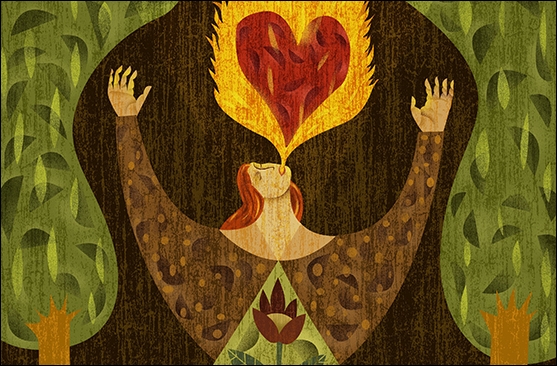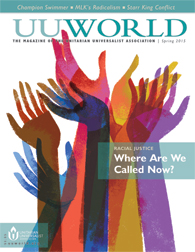
What do we mean when we say ‘religious experience’?
The answer depends on whom you ask, of course.
If you could ask the Unitarian minister and author the Rev. William Ellery Channing (1780–1842), he might describe the life-changing religious experience that seized him as he walked through a meadow, a book (on moral psychology!) in hand. He felt overcome with joy—joy so intense that he longed to die, since it seemed to him only heaven had room enough for emotions this strong. From that day forward religion became for him “another name for happiness,” and he confessed to being “most cheerful” when he felt “most religious.”
Contemporary Unitarian Universalist theologian the Rev. Dr. Thandeka helps participants in her “Love Beyond Belief” congregational workshops sort their religious breakthroughs from their psychological ones. She locates religious experience in those moments when we are most keenly aware that we are part of an interdependent web of life. This awareness is preverbal and preconceptual, she says. It is not a simple emotion but pure consciousness of the whole and of how we are irrevocably linked together.
Because we are all capable of such awareness, Thandeka believes that it can serve as the “noncreedal biological foundation of our religious tradition.” In her view, our shared consciousness of interdependence can provide a common ground for the breadth of UU theologies. Some of us will attach theological images and concepts to this noncreedal foundation, others will not. But these choices need not obscure our mutual experience of connectedness.
In contrast, the Rev. Dr. Kendyl Gibbons, senior minister of All Souls UU Church in Kansas City, Missouri, and former co-dean of the Humanist Institute, situates religious experience in a distinctly moral framework. Her preferred term for a religious breakthrough is “reverence.” Gibbons experiences reverence and awe when she encounters a person in whom she sees both moral good and inner beauty. Morality can be ugly when it passes judgment and condemns people. Beauty can lack power. Together and in balance, however, moral goodness and beauty are awe inspiring. She calls this balance spiritual maturity.
Gibbons sees herself as moving along a continuum; though her vision of spiritual maturity remains incomplete, it calls her always to respond. As she brings herself into closer alignment with her vision (as it currently exists), she remains open to its deepening. Her goal remains ever beyond her reach, but no matter. Her vision has force; it reminds her of what she might become.
For the Rev. John Buehrens, a former president of the Unitarian Universalist Association who currently serves First UU Society of San Francisco, religious experience consists, above all, of transformation. A community-forming power, he believes, constantly nudges us toward genuine mutuality and dialogue, whether we’re chatting with a fellow congregant or participating in a meeting of the pastoral care committee. Unlike Thandeka and Gibbons, Buehrens holds that this community-forming power is external to us. In the company of other UUs, Buehrens makes space for various theologies by referring to this power as “the divine.” Privately, he uses the name God, in keeping with the biblical tradition that undergirds his devotional life.
Buehrens believes that although transformative experiences can come at any time, we are more attuned to the divine in religious settings and thus are more receptive to them.
Channing, Thandeka, Gibbons, and Buehrens all possess distinct understandings of religious experience. Such differences could undermine attempts to find unity in our diversity. However, Buehrens notes that our distinctive form of theological pluralism thwarts any schismatic tendencies.
Whatever the source and nature of your own religious experiences, may they fill you, as they did Channing, with joy. And may you find yourself most cheerful when you are most religious.
This article appeared in the Spring 2015 issue of UU World (pages 54-55). Illustration (above) © Cargo/Imagezoo/Corbis. See sidebar for links to related resources.
Comments powered by Disqus






